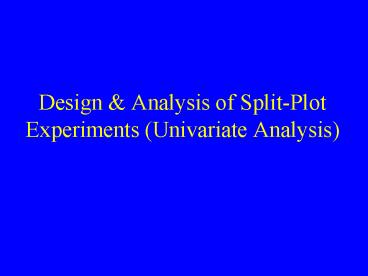Design PowerPoint PPT Presentation
Title: Design
1
Design Analysis of Split-Plot Experiments
(Univariate Analysis)
2
Elements of Split-Plot Designs
- Split-Plot Experiment Factorial design with at
least 2 factors, where experimental units wrt
factors differ in size or observational
points. - Whole plot Largest experimental unit
- Whole Plot Factor Factor that has levels
assigned to whole plots. Can be extended to 2 or
more factors - Subplot Experimental units that the whole plot
is split into (where observations are made) - Subplot Factor Factor that has levels assigned
to subplots - Blocks Aggregates of whole plots that receive
all levels of whole plot factor
3
Examples
- Agriculture Varieties of a crop or gas may need
to be grown in large areas, while varieties of
fertilizer or varying growth periods may be
observed in subsets of the area. - Engineering May need long heating periods for a
process and may be able to compare several
formulations of a by-product within each level of
the heating factor. - Behavioral Sciences Many studies involve
repeated measurements on the same subjects and
are analyzed as a split-plot (See Repeated
Measures lecture)
4
Design Structure
- Blocks b groups of experimental units to be
exposed to all combinations of whole plot and
subplot factors - Whole plots a experimental units to which the
whole plot factor levels will be assigned to at
random within blocks - Subplots c subunits within whole plots to which
the subplot factor levels will be assigned to at
random. - Fully balanced experiment will have nabc
observations
5
Data Elements (Fixed Factors, Random Blocks)
- Yijk Observation from wpt i, block j, and spt k
- m Overall mean level
- a i Effect of ith level of whole plot factor
(Fixed) - bj Effect of jth block (Random)
- (ab )ij Random error corresponding to whole
plot elements in block j where wpt i is applied - g k Effect of kth level of subplot factor
(Fixed) - (ag )ik Interaction btwn wpt i and spt k
- (bc )jk Interaction btwn block j and spt k
(often set to 0) - e ijk Random Error (bc )jk (abc )ijk
- Note that if block/spt interaction is assumed to
be 0, e represents the block/spt within wpt
interaction
6
Model and Common Assumptions
- Yijk m a i b j (ab )ij g k (ag )ik
e ijk
7
Mean and Covariance Structure (Fixed Whole Plot
and Subplot Factors)
8
Obtaining Variances of Sums Means
9
Variances of Other Means
10
Analysis of Variance
11
Expected Values in Analysis of Variance
12
Expected Mean Squares (Fixed WPSP Trts)
13
Tests for Fixed Effects
14
Comparing Whole Plot Trt Means
15
Comparing Subplot Trt Means
16
Comparing Subplot Effects in Same WPT
17
Comparing WPT Effects in Same Subplot TRT
18
Approximate Degrees of Freedom (Satterthwaite)
19
Random WP SP Effects Model
All random effects are assumed to be mutually
pairwise independent
20
Random Effects Model Mean/Variance Structure
21
Expected Mean Squares (Random WPSP Trts)
22
Testing for WP Random Effects
23
Testing for SP Effects and WP/SP Interaction
24
Mixed Effects Model (Fixed WP, Random SP)
25
Mixed Effects (Fixed WP) - Mean/Variance Structure
26
Expected Mean Squares (Fixed WP/Random SP)
27
Testing for WP Fixed Effects
28
Testing for SP Effects and WP/SP Interaction
29
Mixed Effects Model (Random WP, Fixed SP)
30
Mixed Effects (Fixed SP) - Mean/Variance Structure
31
Expected Mean Squares (Random WP/Fixed SP)
32
Testing Main Effects and WP/SP Interaction

